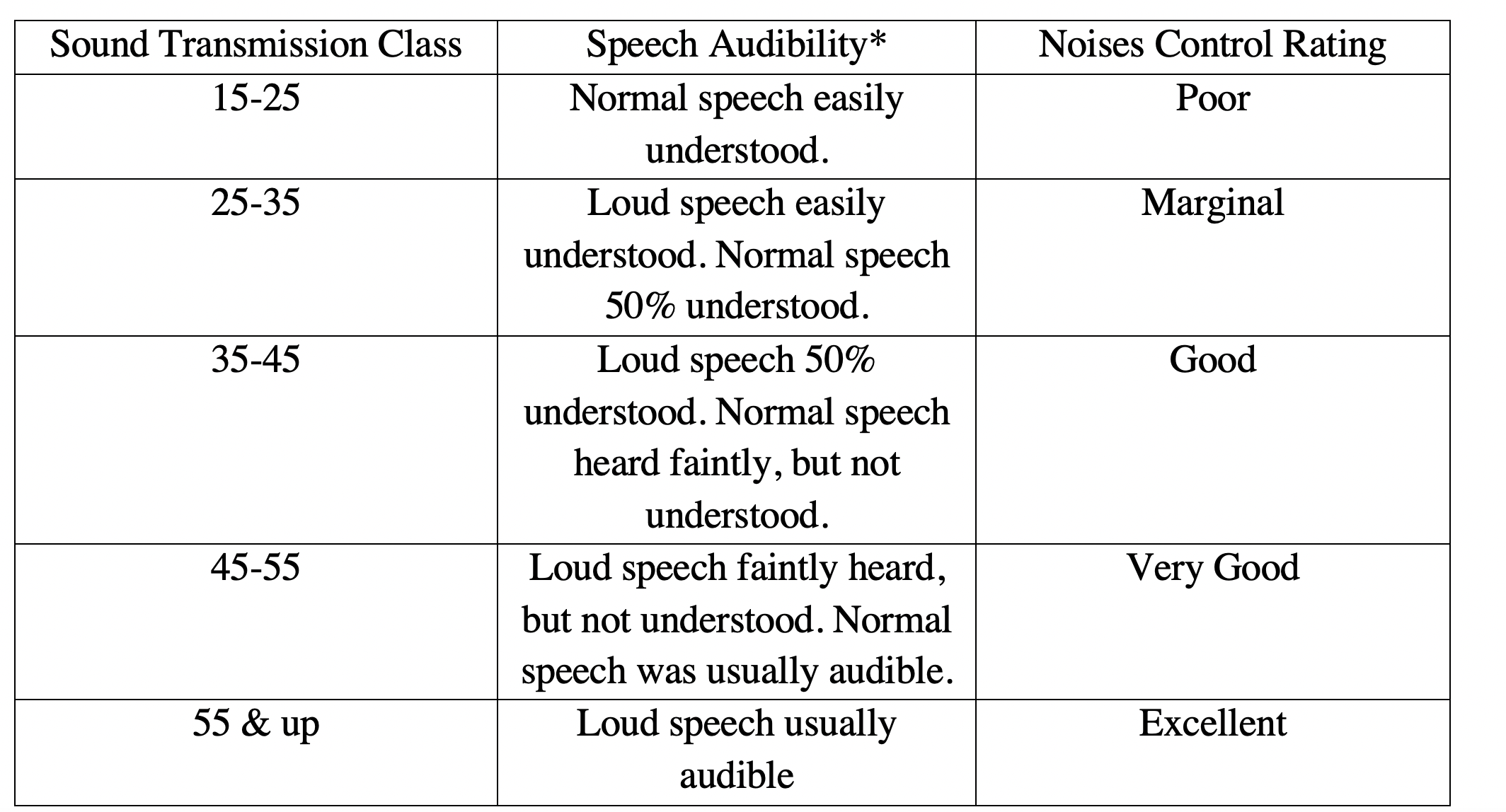Acoustic Comfort
New CommercialWhat is Acoustic Comfort?
Acoustic comfort refers to a building occupant’s experience related to sound in a building or a specific space within a building. A space with good acoustics has a minimal echo, allows for confidential conversations that don’t interrupt others working in the space, and controls excess noise from outside sources as well as sources within the building.[1] Three common noise issues include excess noise from outside, noise from adjacent spaces and noise control issues within a space.[2] Controlling these aspects of sound can help improve indoor environmental quality (IEQ).[3]
The Center for the Built Environment (CBE) at U.C. Berkeley maintains a post-occupancy evaluation (POE) database related to indoor environmental quality that includes input about acoustic satisfaction in office buildings. The main categorization of complaints related to acoustics includes excessive noise, lack of speech privacy, and lack of speech clarity.[4]
Excessive noise issues come from poor sound isolation, which occurs when background noises are too high from outside noises penetrating inside or from noise generated by office equipment or other people.
Speech Privacy issues occur when a speaker is not able to communicate with a listener because the speech becomes indiscernible. Courtrooms, hospitals, clinics, and doctor and legal offices are some of the places most affected, especially considering the private discussions that occur in these spaces. Adjusting the ratio between speech and noise levels can control speech privacy. For example, increasing background noise and reducing the noise energy from speech can improve speech privacy concerns. See sound masking section below for details on how to incorporate this technique.
Speech Clarity issues make communication difficult and stem from excessive background noise and too much reverberation (sound reflecting off various surfaces).
How to Improve Acoustic Comfort
An integrated design process is key to achieving a high level of acoustic comfort. Project goals related to security and sustainability, for example, are sometimes perceived to conflict with acoustic goals but involving professionals from those areas of expertise from the start of the project, helps achieve synergistic goals.[5] The following concepts and terms are important to understand when considering acoustic comfort.
Sound Absorbing Technologies
- Sound Transmission Class (STC): STC is a numerical rating system that measures the ability of a wall, floor, or ceiling to minimize sound transmission. The table below details how the rating system works. Hire an acoustical engineer to address conditions in rooms such as conference rooms and mechanical equipment rooms.[6]

Figure 1 – Sound Transmission Class Ratings (Source: Adapted from NIAIMA’s Noise Control).
- Sound Masking: Sound masking produces unobtrusive sound through speakers installed above ceiling tiles. The background sound reduces interference from distracting office sounds in a manner that also helps make conversations between workers more coherent. Whether installed in an enclosed area or more open office space, adjustments can be made to sound masking. Sound masking can subsequently increase worker productivity as well as improve morale and speech privacy.
- Sound Isolation separates sources of noise from the building’s occupants. For example, mechanical equipment such as a building’s HVAC system can become too noisy and make conversations difficult. Implementing sound-absorbing elements along with the proper STC walls, floor, and ceilings can help mitigate the sounds that a noisy HVAC system may create. Consider the following recommendations to increase sound isolation for HVAC systems:
- Avoid through-the-wall air return louvers that draw air from one room through another in private offices, conference rooms, and other rooms where confidential discussions are expected to occur. All air returns should be ducted.
- Do not locate air supply or return registers close to each other on opposite sides of a partition wall. Doing so causes the sound to pass directly from one room to another, negating the acoustical value of the partition.
- Specify quiet HVAC equipment. Though the price may be somewhat higher, the alternative to using standard equipment may lead to costly and disruptive remediation.
Consider the following recommendations to develop an indoor environment that provides acoustic comfort:
- Specify sound absorbing materials (e.g., walls, carpets, ceilings) and configure spaces to dampen rather than magnify sound reverberation.
- Provide sound masking if necessary.
- Limit transmission of noise from outside by designing high sound transmission class (STC) walls between work areas and high noise areas inside and outside the building.
- Minimize background noise from the building’s HVAC system and other equipment.
- Provide opportunities for privacy and concentration when needed in open plan offices.
- Enclose or separate group activity spaces from work areas when the concentration is essential.[7]
Benefits
Acoustic comfort can reduce stress, protect health, and increase occupant satisfaction and productivity by contributing to a more comfortable environment psychologically and acoustically.
Costs
The cost of implementing strategies to achieve acoustic comfort varies depending on specific project goals and the approach taken. The GSA Sound Matters report in the Resources section below provides costs related to typical partition, wall and ceiling materials. Through increased worker productivity as well as improved indoor environmental quality and the health benefits associated with it, good acoustics can contribute to overall cost savings.[8]
Resiliency
Acoustic comfort is a critical element of indoor environmental quality (IEQ) that affects the health and well-being of building occupants. In the event of a disaster or emergency event, a high-quality indoor environment helps protect building occupants and contribute to a built environment that can provide protection and recovery from hazardous events.
[1] GSA. Sustainable Facilities Tool. Indoor Environmental Quality. https://sftool.gov/learn/about/1/indoor-environmental-quality-ieq (accessed December 26, 2018).
[2] WBDG. Acoustic Comfort. https://www.wbdg.org/resources/acoustic-comfort (accessed December 27, 2018).
[3] National Institute of Building Sciences – WBDG. Acoustic Comfort. September 2018. http://www.wbdg.org/resources/acoustic.php?r=ieq (accessed September 10, 2018).
[4] UC Berkeley Center for the Built Environment. Acoustical Analysis in Office Environments Using POE Surveys. http://www.cbe.berkeley.edu/research/acoustic_poe.htm (accessed December 27, 2018).
[5] WBDG. Acoustic Comfort. https://www.wbdg.org/resources/acoustic-comfort (accessed December 27, 2018).
[6] NAIMA. Noise Control http://insulationinstitute.org/wp-content/uploads/2016/01/BI476.pdf (accessed September 10, 2018)
[7] National Institute of Building Sciences – WBDG. Provide Comfortable Environments. September, 2018. http://www.wbdg.org/design/provide_comfort.php (accessed September 10, 2018).
[8] U.S General Services Administration. Interior Finishes. August 2017. http://www.gsa.gov/portal/content/101251 (accessed September 10, 2018).
